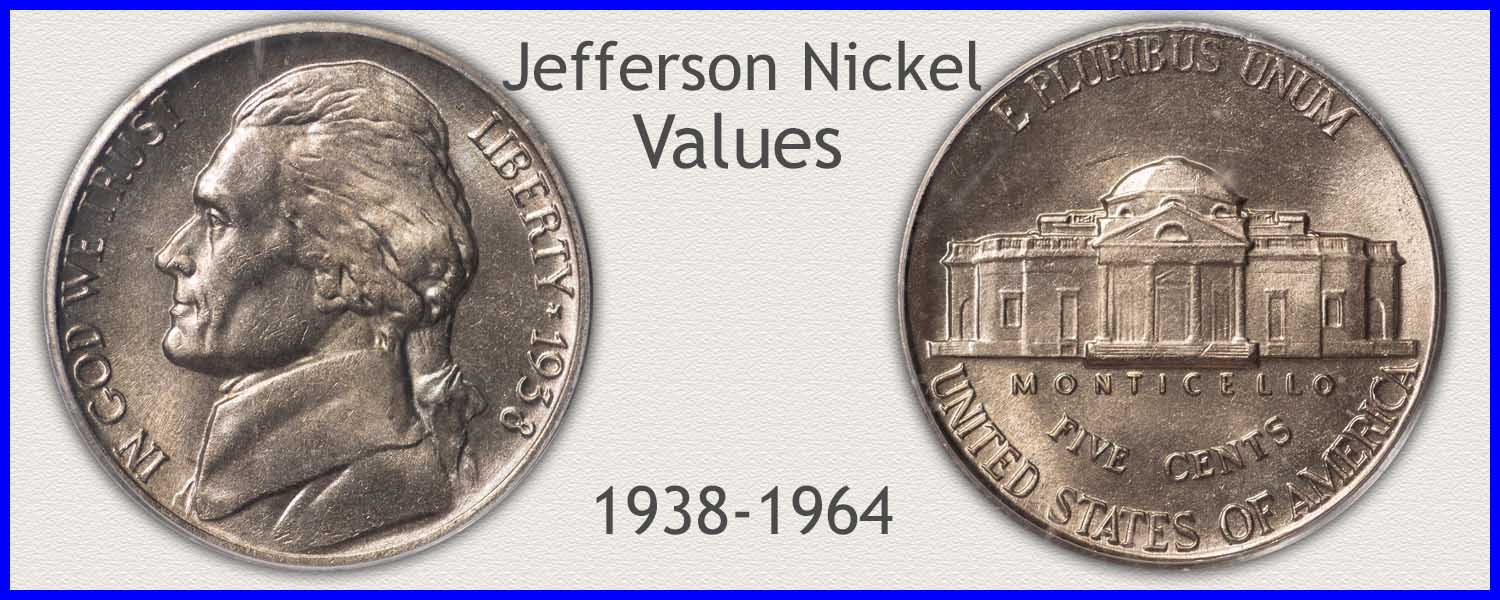Coin Values Moving with Precious Metals: Up-Dated 12/29/2025: Gold $4449 | Silver $75.46
1953 Nickel Value
Ample quantities of nickels available results in 1953 nickel value as affordable. Collectors inspect these vintage nickels looking at dates and mint variety first then noting the eye appeal and wear to the surface.
Proceed through a step-by-step method to identify the qualities collectors are seeking. With condition playing a large role; Step 2 looks for the subtle points of interest to adding value.
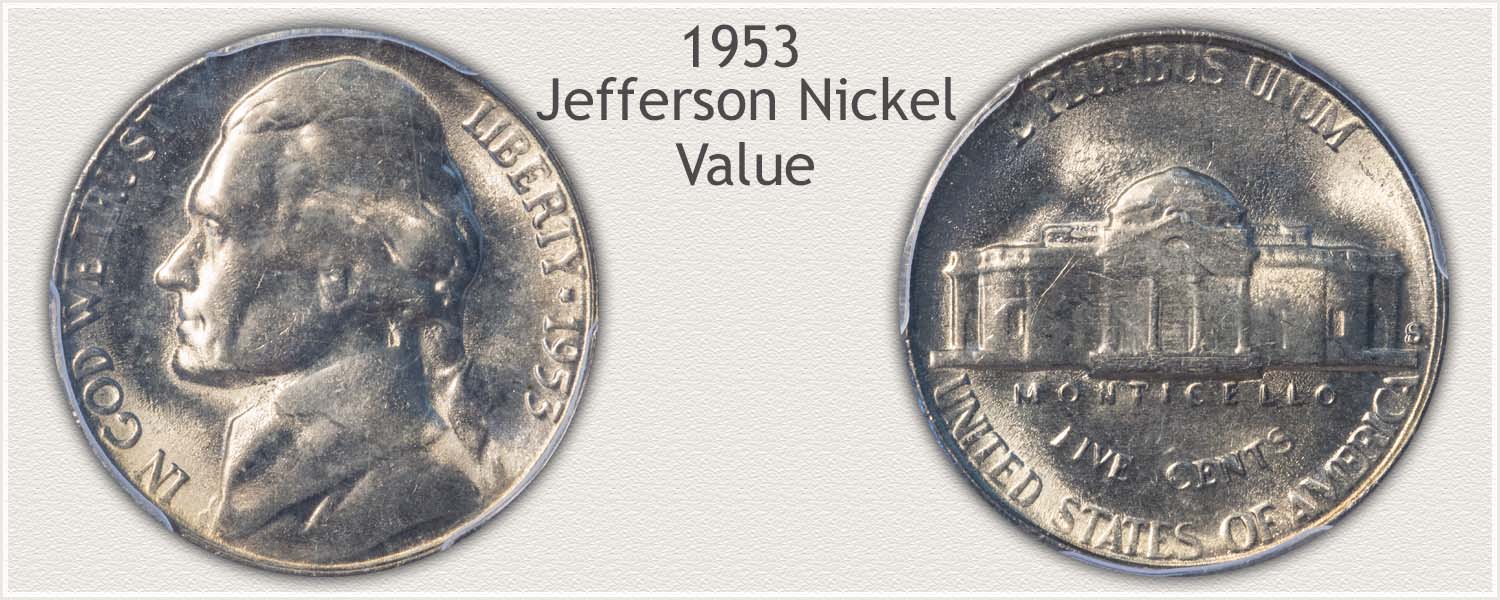
Steps Leading to Value:
- Step 1: Date Plus Mintmark Variety - Listed separately on value charts are three varieties of 1953 nickels. Locate the significant marks to identify the variety.
- Step 2: Grading Condition - Examine the surface of your coin, determine amount of wear and any distracting marks to narrow value range.
- Step 3: Special Qualities - Striking variances are examined to spot higher quality collectible nickels.
| 1953 Jefferson Nickel Value | ||||
|---|---|---|---|---|
| Condition of Coin | ||||
| Date | Good | Fine | Extremely Fine | Mint State |
| 1953 Jefferson Nickel Value Up-Dated | 2025 | |||
| 1953 | $0.05 | $0.05 | $0.05 | $1.18 |
| 1953 D | $0.05 | $0.05 | $0.05 | $0.66 |
| 1953 S | $0.05 | $0.05 | $0.05 | $1.20 |
A vintage 1953 nickel is now becoming a very old coin. Collectors over the years have realized the quality of the coins minted in 1953 varies greatly. The amount of detail within the design elements ranges from crisp to faded, affecting eye appeal.
Using a few steps and comparing to images identifies the variety and quality separating a collectible nickel from the rest.
Step 1: | Date and Mintmark Variety Identified
Identify the Varieties of 1953 Jefferson Nickels
1953 saw a total of over 125 million nickels struck and released into circulation. This is a typical number of coins for the vintage eras of the Jefferson series. Three mints struck nickels and each is identified by either the presence of a mint mark or absence of a mark.
All mint varieties of 1953 nickels are collected as part of a complete set forming a base value to collectible quality examples. Recognition of the mint variety is important in the Mint State grades to place an accurate value.
1953-S Jefferson Nickel
"S" Mintmark on Reverse: San Francisco Mint Struck the Coin
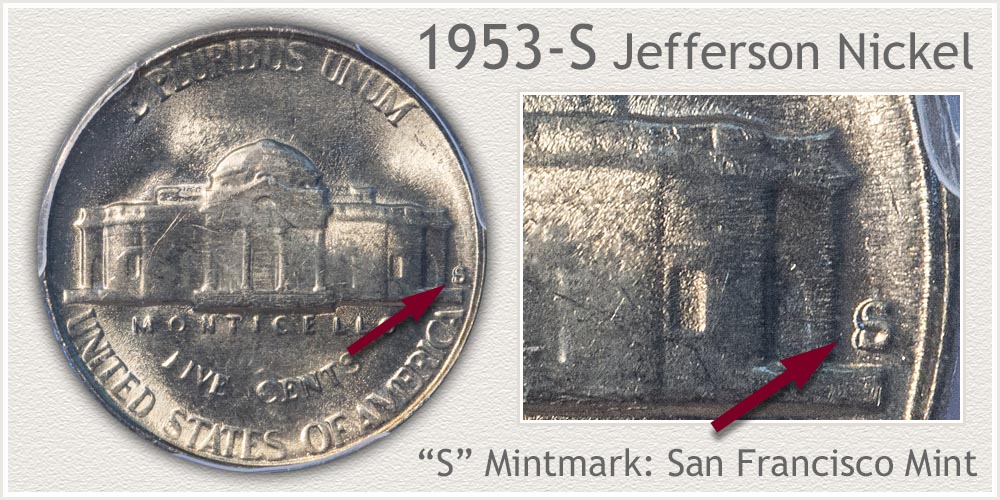
San Francisco mint followed a similar pattern of previous years in striking the fewest nickels of the mints. With just over 19 million "S" mintmark nickels these remain in abundant supply. The collectible quality in demand are coins without any wear to the surface.
An "S" mintmark identifies the San Francisco mint. On the reverse next to Monticello is the location of the "S" mintmark. These marks are small and next to the rim.
1953-D Jefferson Nickel
"D" Mintmark on Reverse: Denver Mint Struck the Coin
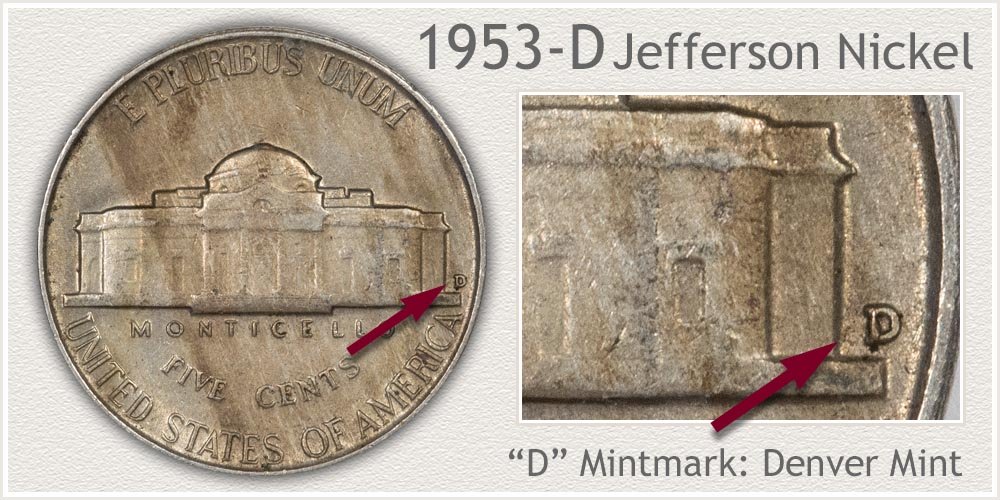
1953 marks a new trend of the Denver mint producing more nickels than Philadelphia per year. In the vintage era prior to 1953 the leading producer was Philadelphia of all mints. Denver struck 59,878,600 1953 nickels over 10 million more than Philadelphia. These are a mint variety encountered in quantities.
Denver's mintmark is a small "D" placed on the reverse. Just next to the right of Monticello a small "D" mark indicates Denver mint production.
1953 Jefferson Nickel
No Mintmark on Reverse: Philadelphia Mint Struck the Coin
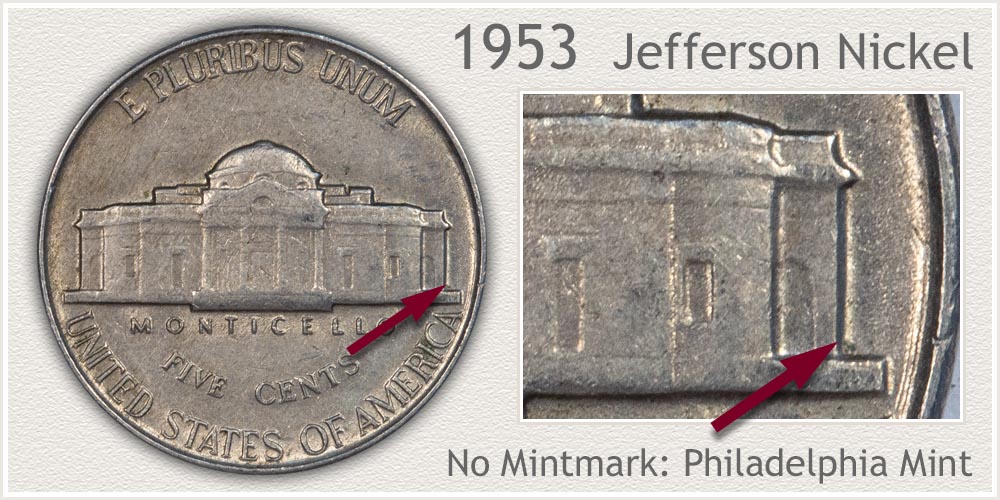
Philadelphia mint 1953 nickels remain abundant in supplies. The major consideration to value is condition of the coin. 46.7 million were coined and circulated for many years, becoming worn. Collectors search for examples with no wear to the surface. These coins in mint state grade are popular, available, and the quality placed into many collections. Judging condition is an important step in recognizing premium value.
The third mint variety is confirmed by absence of a mint mark. On the reverse to the right of Monticello, if the space between the building and the rim is empty, the nickel was produced by the Philadelphia mint. No mint mark was used by Philadelphia in 1953.
Step 2: | Grading Condition Narrows Value Range
Collectible Grades Define 1953 Jefferson Nickel Value
The process of grading takes a close look at the surface quality and condition of the coin. 1953 nickels are available in quantities and the search is for lightly worn or better examples. Identifying the small details needed to reach high grades recognizes a quality nickel in demand by collectors.
Eye appeal of the coin is first noted, is it crisp with fine details remaining? Jefferson's portrait is still bold and hair displays many small lines on coins approaching top condition status.
Mint State Grade
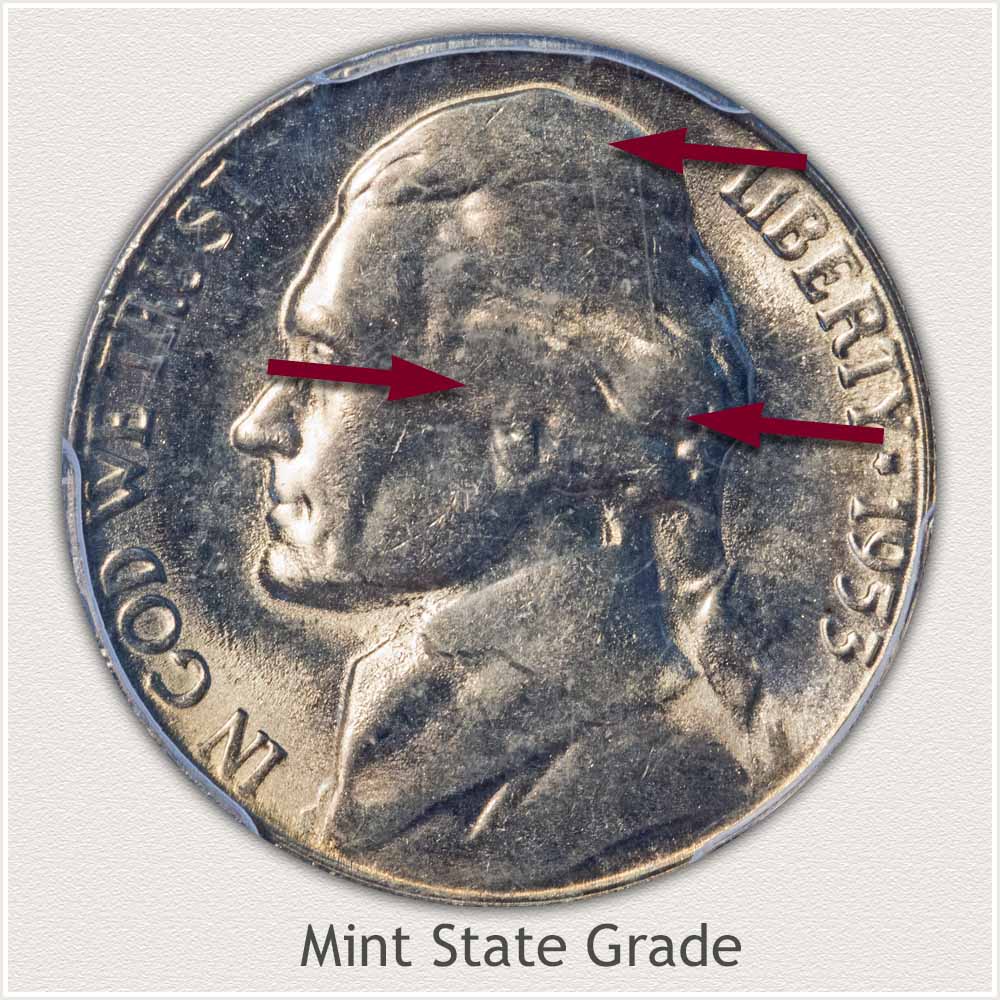
Mint State: Defining the top grade is absence of wear to the surface. All newly minted nickels have a shimmering mint luster to the surface, the result of the intense pressure when striking a coin. Luster covers all areas and is prone to quick removal of high spots when worn.
Inspecting the hair above the ear begins to determine if luster remains. High in profile hair lines and luster are present above and behind the ear on the example 1953 nickel. Two rounded contours of hair are high points just behind the ear. Both are covered in the fine texture of luster and show no change in color from surrounding areas.
This well struck example displays continuous luster over the entire surface. No dulling of the metal breaks the shine when the coin is tilted under a single light source.
Extremely Fine Grade
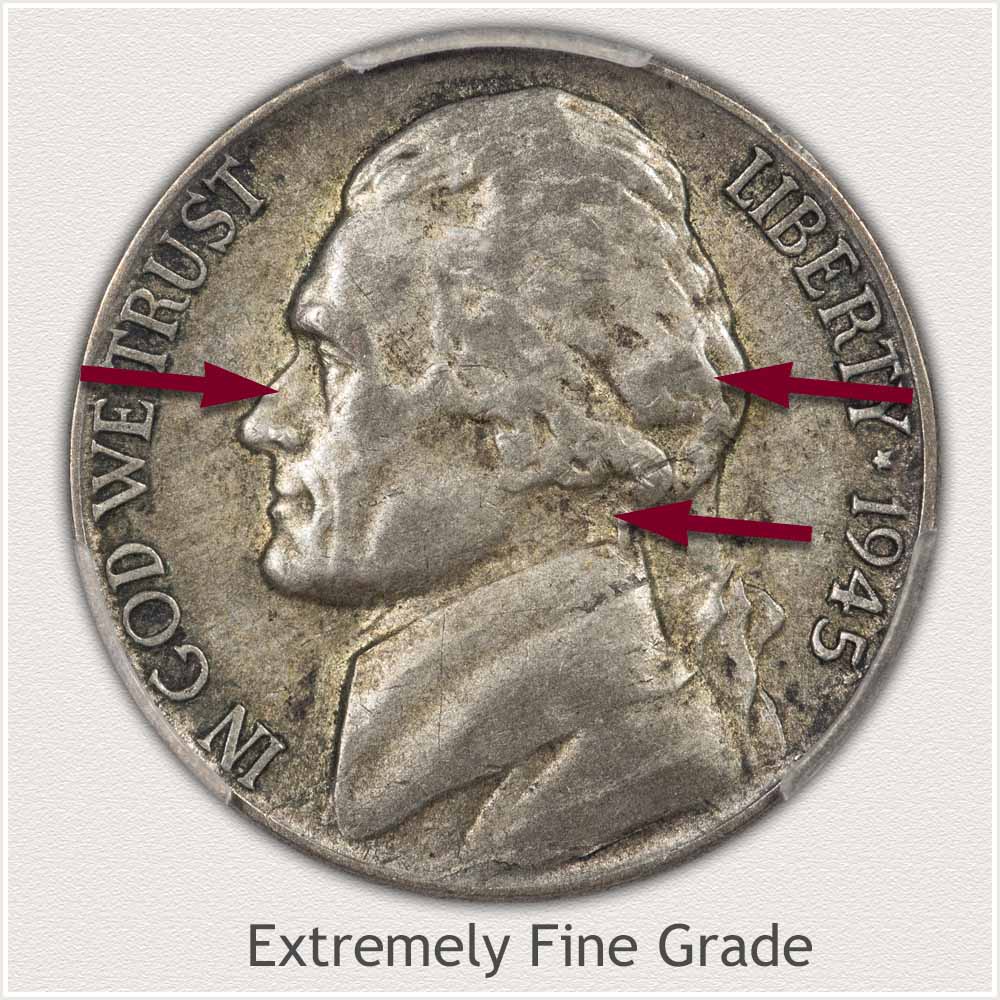
Extremely Fine: Light wear is seen on the very high points of the design with complete separation of minor details. Although wear has reduced the metal, no merging of major and minor details is evident. A crisp look helps recognize the Extremely Fine grade.
Note the hair detail just above the ear. Wear has flattened all the high points leaving the major contours. Hair detail behind the ear is fully separated into two major contours with remaining finer strands. Scattered flattening with just slight blending is helping the eye appeal and confirming the grade.
Jefferson's face remains boldly contoured with small, disconnected flattened areas. A pleasing example of a vintage nickels.
Low Grade Examples
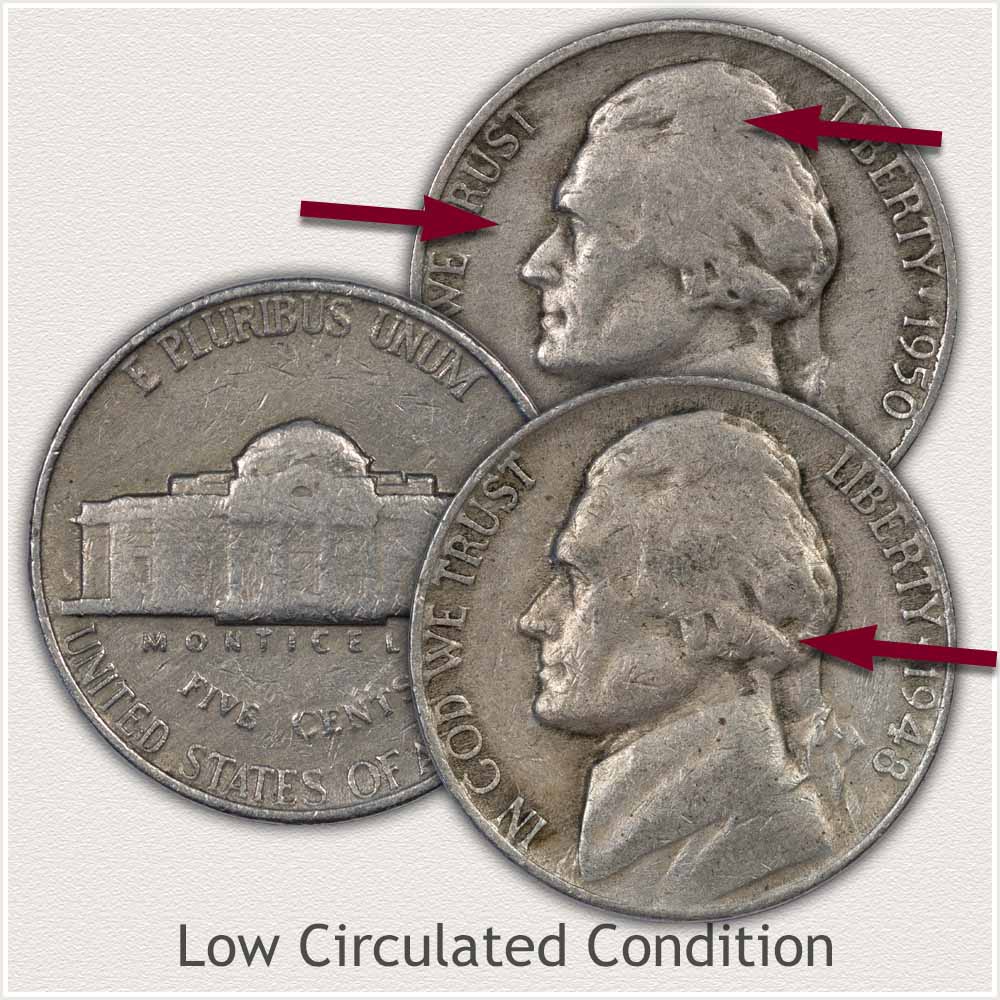
Low Grade Condition: Worn 1953 nickels below the Extremely Fine grade are abundant and low premium coins. Moderate to extensive wear has reduced the aesthetics of the design and appeal. Abundant in numbers, availability of low-grade vintage nickels is exceeding demand.
Jefferson's hair is giving the impression of one continuous flat area. Details of hair strands above the ear are missing replaced by a flat surface. Two contours of hair behind the ear are smooth and distinctly flattened. Neither of the areas behind the ear show finer hair lines. Wear has flattened Jefferson's face, connecting his eye brow, cheek, and jaw line.
On a positive note, affordability of these moderately worn nickels provides a low cost opportunity for new and young collectors to assemble a vintage nickel collection.
How to Video: Grading Jefferson Nickels
Video, Images and Descriptions | Grading Jefferson Nickels
Step 3: | Special Qualities Enhancing Value
Subtle Detail to High Quality and Value
Overall eye appeal of a coin is often the deciding factor if a collector desires a coin and places it in their collection. Collector demand and preferences are the base to all nickel values.
A subtle feature sought by today's collector is bold strike qualities of Jefferson nickels. Large numbers of nickels were struck each year, not all display a crisp and bold strike. Soft details within the hair and lettering often give these coins a lower quality appearance.
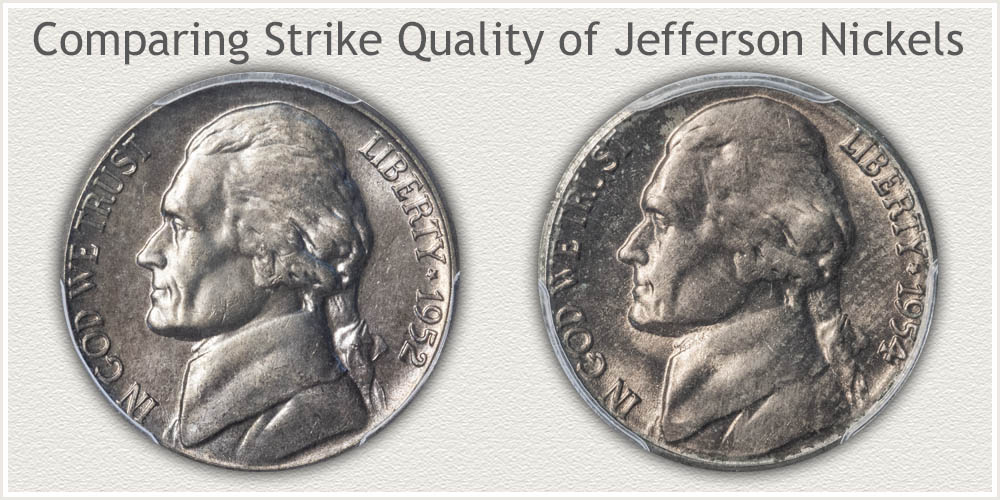
Both examples are mint state coins, no wear to the surface. However, both are of different quality when considering eye appeal and aesthetics. The boldly struck coin displays a depth of design and vibrancy, a high-quality strike. On the right, a soft strike results in missing depth to the finer details and crisp lines of the lettering, a faded "look" is the overall impression.
High grade nickels: mint state to extremely fine grades are first judged for the technical qualities. Mint state grade, no wear to the surface. Extremely fine grade, light wear only on highest points of design. A further judgement is made of the strike quality; does it add to, or diminish eye appeal.
1953 nickels are found with both high-and low-quality strikes. High quality, boldly defined examples represent a challenge to collectors and worth recognizing. When judging quality of your coins set aside the noticeably bold, crisp examples in both mint state and lightly circulated condition.
References
U.S. Mint. 1954 U.S. Mint Annual Report https://nnp.wustl.edu/library/book/343
Coin Values | CoinStudy Articles
Date by Date
In Depth Jefferson Nickel Values
1938 to 1964
Jefferson Nickel Values | Discover Their Worth
A key to Jefferson nickels and values is condition of the coin. Special attention is given to grading using images to compare and identify condition. Value charts now highlight the dates and mintmarks with premium listings.
Rare nickels are found throughout each series with many dates ranging from the beginning of the denomination to modern nickels. A listing of rare nickels with images to help identify the important features.
Print the Coin Values Worksheet
Record the different groups of coins as you sort them. Coins of higher value are listed individually on the worksheet. The worksheet becomes a convenient and organized summary of your Jefferson nickels.
Safe Coin Storage | Recommendations
Recommendations on basic supplies that greatly improve coin storage. Providing for safe handling, preserving of value, and organizing your box of old coins.
★ Coin Values Discovery finds 1953 Jefferson Nickel Value and...
All old U.S. coin values. Follow an image index to identify all U.S. coin series, from Cents to Gold. Value charts, grading images and a step-by-step procedure uncovers how much your box of old coins is worth.
